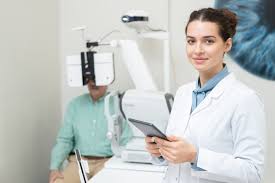In our modern age, the ubiquity of computers and other digital screens has become integral to work, education, and leisure. However, prolonged exposure to these screens can give rise to concerns about the potential impact of computer radiation on eye health. This guide aims to provide practical insights and expert advice on safeguarding your eyes from computer radiation. In this thorough guide, we delve into the expert guidance provided by the top ophthalmologist, Dr. Qasim. He imparts valuable insights and practical tips on protecting our eyes from the potential harm associated with prolonged exposure to computer radiation.
11 Tips to Protect Eyes From Computer Screen Radiations
Understanding Computer Radiation
Before delving into protective measures, it’s crucial to understand the nature of computer radiation. Electronic devices, including computers, emit low levels of electromagnetic radiation, primarily in the form of blue light. Prolonged exposure to this blue light, combined with other factors like screen glare and improper viewing distance, can contribute to digital eye strain and potential long-term effects.
Implementing the 20-20-20 Rule
One of the most effective ways to reduce eye strain and minimize the impact of computer radiation is to adopt the 20-20-20 rule. Every 20 minutes, take a 20-second break, and look at something 20 feet away. This simple practice helps relax the eye muscles and reduces the continuous stress caused by staring at a screen.
Blue Light Filters and Screen Protectors
To mitigate the impact of blue light, consider using blue light filters or screen protectors. These accessories are designed to reduce the amount of blue light emitted by the screen, helping to alleviate eye strain. Many devices also come equipped with built-in blue light filter settings that can be activated, especially during evening hours.
Adjusting Screen Settings
Optimize your computer’s display settings to reduce eye strain. Adjust the brightness and contrast to a level that is comfortable for your eyes. Additionally, consider changing the color temperature to warmer tones, as this can reduce the intensity of blue light emitted by the screen.
Using Anti-Reflective Coatings
Anti-reflective coatings on eyeglasses can significantly minimize glare from computer screens. These coatings reduce reflections and increase the amount of light that reaches the eyes, enhancing visual comfort and minimizing eye strain caused by screen glare.
Correct Viewing Distance and Angle
Maintaining an appropriate viewing distance and angle is crucial in reducing the impact of computer radiation. Position your screen at eye level and about an arm’s length away. This ensures that your eyes are not forced to constantly adjust to an uncomfortable angle, minimizing strain.
Blinking Exercises
Prolonged screen time often leads to reduced blinking, contributing to dry eyes and discomfort. Incorporate blinking exercises into your routine. Every 20 minutes, consciously blink several times to moisten the eyes and prevent dryness.
Outdoor Breaks
Regular breaks, especially outdoors, can offer a respite from continuous screen exposure. Natural light not only provides a break for your eyes but also helps regulate your circadian rhythm, positively influencing overall well-being.
Computer Screen Glasses
Consider using computer glasses with anti-reflective coatings and blue light filters. These specialized glasses are designed to optimize vision during prolonged computer use, reducing eye strain and minimizing the impact of screen-related radiation.
Regular Eye Check-ups
Schedule regular eye check-ups with an optometrist or ophthalmologist. Regular examinations can detect changes in your vision and help address any underlying issues before they escalate.
Ergonomic Workspace Setup
Ensure that your workspace is ergonomically sound. Proper lighting, comfortable seating, and an organized desk contribute to an environment that is conducive to eye health.
Final Thoughts
As we continue to integrate technology into our daily lives, protecting our eyes from computer radiation becomes paramount. By adopting these practical measures – from the 20-20-20 rule to using blue light filters and maintaining correct viewing distances – you can significantly reduce the impact of prolonged screen exposure on your eyes. Consulting with eye care professionals and incorporating these strategies into your daily routine will not only safeguard your vision but also enhance your overall well-being.
Read More: How To Protect Eyes From Mobile Phone











